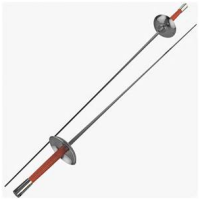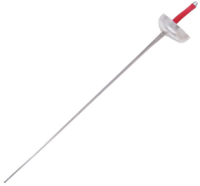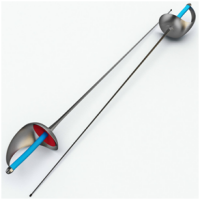About Fencing - Weapons & Styles
 The
Foil The
Foil
The foil originated as the training weapon for
the small sword which was a popular sidearm in the 17th and
18th centuries. The modern foil has flexible, rectangular
blade and its overall weight is less than a pound. In competition
points are only scored by contact when the foil's tip makes
contact with the opponent's valid target area, which consists
of the torso and the groin. The head (except the lower neck
portion of the mask), arms, and legs are considered off target,
and touches made in these locations do not count for points,
but do stop play. Foil fencing is also governed by the rules
of priority or right of way. Under these rules, points are
not necessarily awarded to the first fencer to hit, but to
the fencer who hits with priority which is generally established
when one fencer starts a correctly executed attack. The foil
is the most commonly used weapon in competition.
 The
Epee The
Epee
The modern epee evolved from the small sword
which was a popular sidearm in the 17th and 18th centuries.
The epee has a three-sided blade which is generally heavier
than the foil and sabre blades. The epee also has a bell shaped
guard to protect the hand holding the weapon. In competitions
a valid epee touch is scored if a fencer touches the opponent
with enough force to depress the tip. In epee fencing, the
opponent's entire body is a valid target area and there are
no rules concerning priority or rights of way as in foil fencing.
Epee fencing is the method of sport fencing that most closely
resembles dueling.
 The
Saber The
Saber
Saber fencing differs from foil and epee fencing
because it is it is possible to score with the edge of the
saber's blade. For this reason, saber movements and attacks
are very fast. However, Saber fencing is similar to foil fencing
because it uses the rules of priority, or rights of way, to
determine who acquires the scoring touch. The cross-section
of the saber blade is Y- or V-shaped, unlike the quadrangular
shape of the foil, but not as stiff as the epee. The bell
guard of the sword is curved around the handle, giving the
fencer hand protection from cuts as well as thrusts. The target
area for the saber consists of the torso above the waist,
as well as the arms and head (excluding both hands).
|


